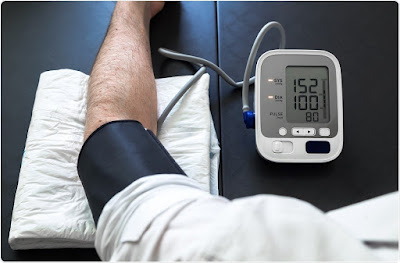In this article:
Why is it important for you to monitor your blood pressure?
Ambulatory blood pressure monitoring
Home blood pressure monitoring
What your readings mean
Why is it important for you to monitor your blood pressure?
Ambulatory blood pressure monitoring
Home blood pressure monitoring
What your readings mean
The ideal method of checking your blood pressure is ambulatory blood pressure monitoring, which uses a portable recorder. The Oxford Learners' Dictionary define ambulatory as 'related to or adapted for walking'. Thus this is a monitor adapted to check your blood pressure as you go about your usual daily routine. If this is inconvenient or uncomfortable, then readings can be taken using a traditional blood pressure machine at home (home blood pressure monitoring).
Why is it important for you to monitor your blood pressure?
Some people find it a bit anxious and stressful to have their blood pressure checked in a doctor's office. This can then cause their blood pressure to go up in that situation. This is known as white coat syndrome. If your blood pressure is raised, the doctor will not know if this is because of the stress of being in the clinic or hospital (white coat high blood pressure) or because your blood pressure is usually and persistently high, even when relaxed at home. A persistently high blood pressure is known as hypertension. See the separate article, High Blood Pressure (Hypertension). The article you are now reading is just about ways of recording your blood pressure.The unit for measuring blood pressure is known as millimetres of mercury, or mm Hg for short. The National Institute for Health and Care Excellence (NICE) recommends that if your blood pressure is found to be 140/90 mm Hg or above, you should check it at home and during your normal day-to-day activities. The best way to do this is using an ambulatory blood pressure monitor which can be worn for 24 hours a day. But, if you find this uncomfortable or inconvenient, a home blood pressure monitor can be used.
Ambulatory blood pressure monitoring is also sometimes used to check how well medicine used to treat hypertension is working. Also see the separate article, Medicines for High Blood Pressure.
Ambulatory blood pressure monitoring
The ambulatory blood pressure monitor checks your blood pressure at frequent intervals throughout one day and one night. It consists of a cuff which wraps around your arm. The cuff is attached to a small electric recording device on a belt or strap worn on your body. The doctor or nurse who supplies the device should make sure the cuff is the right size for your arm. You should keep the device safe and dry and not have a bath or shower whilst wearing it. From time to time you will feel a tightening sensation in your arm. This is whilst the cuff is inflating to take your blood pressure. It will not last very long and most people will not be worried by it. Try not to move your arm whilst the cuff is inflating. If the device cannot record your blood pressure it will try to repeat the process up to three times. The machine is usually set to record twice an hour whilst you are awake and hourly at night.The ambulatory monitor can be worn whilst you go about your everyday activities. So, it will give an accurate impression about how your blood pressure behaves under normal circumstances. The doctor will look at multiple readings spread throughout the day. (The minimum number is 14 but it may be many more than that.) The results will help your healthcare team decide whether or not you have high blood pressure (hypertension).
Home blood pressure monitoring
This is an alternative to ambulatory blood pressure monitoring. The process for doing this will be exactly the same as that used by the doctor or nurse in the clinic or hospital. You may have to buy or be given a blood pressure monitor to use at home. Wrap the cuff around your arm just above the level of the elbow. (Check the instructions with the monitor to make sure the tubing is in the right position.) You should be seated comfortably with your arm supported (for example, on a table) at the level of your heart. Press the button to inflate the machine and then make a note of the reading. See image below. |
| An electronic blood pressure monitor being used at home |
What your readings mean
If your blood pressure is below 140/90 mm Hg at the clinic or hospital, it will be considered normal.If your blood pressure is above 140/90 mm Hg at the clinic or hospital but your average ambulatory or home reading is below 135/85 mm Hg, it will be considered normal.
If your blood pressure at the clinic or hospital is 140/90 mm Hg or above and your average ambulatory or home reading is 135/85 mm Hg or higher, it will be considered high.
Reference(s)
1). NICE (August 2019). Hypertension in adults: diagnosis and management.
2). Stevens SL, Wood S, Koshiaris C, et al; Blood pressure variability and cardiovascular disease: systematic review and meta-analysis. BMJ. 2016 Aug 9354:i4098. doi: 10.1136/bmj.i4098.
3). Hermida RC, Smolensky MH, Ayala DE, et al; 2013 ambulatory blood pressure monitoring recommendations for the diagnosis of adult hypertension, assessment of cardiovascular and other hypertension-associated risk, and attainment of therapeutic goals. Chronobiol Int. 2013 Apr30(3):355-410. doi: 10.3109/07420528.2013.750490.
4). Arakawa T; Recent Research and Developing Trends of Wearable Sensors for Detecting Blood Pressure. Sensors (Basel). 2018 Aug 2318(9). pii: s18092772. doi: 10.3390/s18092772.

No comments:
Post a Comment
Got something to say? We appreciate your comments: